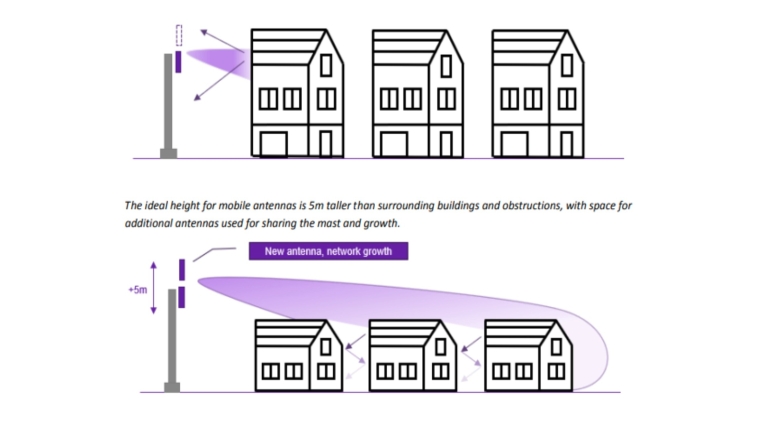
The Government is looking at updating the National Environmental Standard on Telecommunications Facilities (NESTF) which govern how tall telecommunications towers for mobile services can be, with providers saying the current regulations haven't kept up with increasing building heights.
In the briefing for the incoming Minister for Media and Communications Melissa Lee, the industry is asking for the NESTF reforms to be fast-tracked, as without an update there is a "significant risk that the rollout of 5G networks and improvements to the resilience of infrastructure will be hindered."
Ideally, antennae for wireless voice and data service should be five metres taller than surrounding buildings and obstructions.
Today's regulations allow for medium density housing of up to 12 metres in height, which is taller than permitted masts for communications presently.
The towers should also have sufficient space on them to cater for providers sharing space on the mast, and additional antennae for capacity growth.
Paul Brislen, the chief executive of the Telecommunications Communications Forum said the industry organisation wants the regulations to be reviewed.
"The sector supports a review of the NESTF as it's out of date. The current standard was introduced in 2016 and the built environment has changed substantially since then," Brislen said.
"If we are to roll out 5G and increased resilience measures we will need the regulatory tools to do so," he added.
The next step for the Government is to discuss the NESTF update with the Minister for Resource Management Act reform, Chris Bishop.
Ambitious six month programme of work for communications
On top of taller telco masts, the Government has agreed to progress a review of fees under the radiocommunications regime.
The radiocommunications fees were set below cost in 2017, reflecting an accounting surplus, but now the Government wants to look at the charges under the Act, "to ensure that MBIE can be an efficient and effective regulator".
Developing policy objectives to assigning radio frequency spectrum in the 24-30 GigaHertz band for use by mid-2026 will also take place. A work programme with technical work, industry consultation, engagement with Māori, assignment processes and more will take place between now and then.
Policy and technical planning work for spectrum in the 2300 and 2600 MHz bands, used for mobile services, is also starting. That spectrum is used for mobile services, with existing management rights expiring in 2028-2030; rights renewals and reallocation work typically begins five to six years ahead to allow for enough lead-time.
The Radiocommunications Act and regulations also face a review as the Government wants to make the law more efficient and fit for purpose to allow for dynamic spectrum sharing.
Government investment in resilience mooted
Although New Zealand's communications infrastructure is deemed to have "a reasonable degree of resilience", the briefing for the incoming minister points out that vulnerabilities remain.
This is due to the country's topography and non-commercial nature of many resilience investments.
Government or private sector investment to harden telecommunications infrastructure against natural disasters and the impact of climate change is required, or New Zealanders will face more outages like those caused by last year's Cyclone Gabrielle, the briefing said.
Total operational appropriations for Media and Communications for the 2023-24 year amount to $150 million. These will drop sharply the following years, to $100.643 million in the 2024-25 year, falling to $52.2 million in 2027-28.
10 Comments
Sales of tinfoil will go through the roof.
Having taller towers is one solution. Another solution is having more of them.
And in the latter solution, co-opting everyone's home wifi routers to become part of the 5G network is also an option. (Which is where the concept of 5G started, i.e. bouncing a signal from one wifi device to another and then another until it reached a 'primary node' and could then be routed over far larger networks. We used to do exactly this at large sites although the 'hand-over' between wifi nodes as you moved around wasn't as seamless as the tech in a 5G network makes it now.)
I would have thought Gabrielle would have shown the need for stronger backup power supplies , and a backup communication system. i.e hilltop towers that can do line of sight communication, if the fibre is broken .
Ideally, antennae for wireless voice and data service should be five metres taller than surrounding buildings and obstructions.
Today's regulations allow for medium density housing of up to 12 metres in height, which is taller than permitted masts for communications presently.
Visual pollution, congratulations urban planners. Do you realise that residents do not want this?
4G is plenty fast and avoids most of these problems
Have to agree to be honest, unless you have like 3 or 4 people in the house all trying to stream Netflix at the same time its fast enough. Your 4G connection is probably not the bottleneck most of the time, the actual connection speed to the server you are trying to access is usually way slower anyway.
Telco industry asks for urgent mobile tower height rules change?
Have they considered utilising Starlink? Will be mobile ready in the year(s) to come.
Starlink is expensive and slow, and would stand no chance of carrying even half the current traffic. As you say, maybe in the future. The very far future. I doubt it could ever be the primary carrier. Horses for courses.
Why can't the Telcos fit them on the top of the buildings?
That works for commercial buildings but good luck getting enough people to agree to put a cell site on their the roof of their house

We welcome your comments below. If you are not already registered, please register to comment.
Remember we welcome robust, respectful and insightful debate. We don't welcome abusive or defamatory comments and will de-register those repeatedly making such comments. Our current comment policy is here.